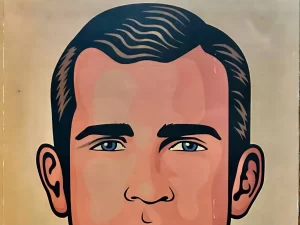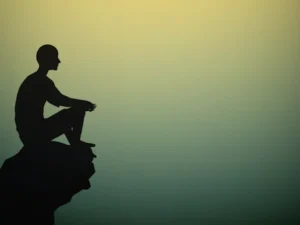Is an artist with a deep commitment to the manifestation of the correlation between the known and the unknown. From an early age Roberto has been in search of the deeper meaning of how and why things are the way they are…
Using painting as his medium of expression, del Río refers to ancient and modern symbology as a form of juxtaposition. His intention is to reveal the untold story of what it means to be human.
Where we have come from, our ancient origins, and the now so widely accepted theory that we may be living in a simulation. His belief is that modern science and its tools will soon be able to explain the compelling language that nature has been trying to tell us for thousands of years.
We are now entering a new cosmic phase in which intuition and perception will be used mechanically by human beings to unveil the secret “real” origin of our species and the matrix that is the basis of all…
In his use of art as a form of cosmic propaganda, del Río is meticulous in the choice of information that’s on display in his body of work. Painting as a means of historical communication and not simply aesthetic.
Why did you tape your toys to the wall as a child?
Where I used to live as a child there [was] a lot of construction taking place. They were building homes, and after the workers went home, I used to go in those houses and started taping things and putting all my toys inside concrete walls. Specifically why? I don’t know, but ever since I [can] recall, I’ve been doing that stuff.
How did that practice evolve into your current mixed media work?
It’s a pretty interesting question. Actually it just like resuscitated after we moved into our Houston [home?] a couple of years ago. Soon after we moved into Houston … it just came back to me, I just felt like starting taping things again. And ever since—it’s been like three years now—I haven’t stopped gluing stuff on my paintings… All my paintings now have collage, and they have something that’s glued to them.
You attended film school in Mexico City. Are you a filmmaker?
It used to be a hobby and then I went to film school. But I started realizing when I was in film school that what I really liked was set design. I was not that much involved in the filming process or the editing process. I didn’t like it that much, I did not like the timetable and the schedule they used. But I decided to start doing set design, so that’s when I just skipped film school and I started going to commercials, TV commercials, and I got involved in set design. And while being a set designer I started liking a lot more the painting process. That’s when I decided to become an artist.
How is your mixed media work cinematic—or is it cinematic?
Well …. there are certain aspects of some of my works that I do separate frame by frame like in cinema, but what I actually like about paintings is that you freeze the moment while painting in it, and it’s just one single thing, it’s just like a little aspect of the whole thing. And filmmaking is completely different, it’s like a grouping of many aspects that make one thing.
Your mother is an artist. And yet you say you have only been an artist—well in July [2011] you said for four years; it’s probably closer to five years now. You describe yourself as self-taught. What took you so long to come around to being an artist?
It’s funny because I never thought I would become an artist. I remember I used to do it for fun. Like any other kid, I liked to draw and stuff. But my problem was a little bit different because I not only liked to sketch and draw, I liked to do other aspects of it. For example [in kindergarten?] I remember in art class they gave us canvases and I didn’t like canvases that were just two-dimensional, I wanted them to be three-dimensional. So I had this weird feeling that I was going to do that one day, but I wasn’t sure. My dad is a businessman and I thought I would be a bit more involved in the business. I knew I wanted to do something related to the arts, but I didn’t know if I wanted to focus on music, films, filmmaking. I don’t know, there was something about painting, just the act of painting, that got me.
You told me you were practically raised in San Antonio. Tell me about your time in San Antonio. My family on my father’s side used to have a house in San Antonio so like every single time we had a vacation or a holiday we went there, so yeah basically since I was like two years old till I was like fifteen or sixteen, all my holidays I went to San Antonio.
You say that all of your works are autobiographical. In some sense isn’t every artist’s work a reflection of himself or herself?
When it comes to my kind of work or a little bit more abstract kind of work, I do believe that everything about it is putting a print of what they feel about life. Yeah it’s autobiographical. At first I don’t realize it on the work I’m working on. I start realizing it must do a little bit with what I’m living right at the moment, so my feelings turn out to be colour, you know.
Your feelings turn out to be in color?
I have certain colors for certain feelings. If I feel happy I love blue, and if I feel sad I love green. I don’t know, it’s something I’ve done since I was a little child. I like imagining myself in colors.
Can you describe the many layers and media of a typical artwork?
Sure….I do mix encaustic with oils and [I] do a lot of layers because I like to apply layers sort of like someone that’s building a house. I like the process of applying layers, letting it dry, and just working on top of it with another layer, different color, and start like [scraping?] it out and just working yourself around that. And now, ever since I moved back to Mexico, I’m working on a new series that’s like urban collage. I’m pasting things. I like to paste things from where I’m living. Like in Houston I used to go to warehouses and to the Texas Art Asylum and different places like that. And I like to buy things, old things, that used to belong to people that are no longer here with us and just turning them out into a painting or something with more significance. On certain works I apply more than, I don’t know, thirty-four to sixty layers of paint. And in some others I just look at it, I put a couple of layers and I say voilà, I like it the way it is. So, it depends on the mood.
How and why do you feel you’re immortalizing found objects?
Just by existing, I think they’re already immortalized, and I do believe that everything is immortalized [because] even if it’s melted down or if it’s buried or whatever, it just comes back again. It’s like a cycle, nothing disintegrates. Everything is here forever, so well, going back to found objects, I like the feeling of getting ahold of something that used to belong to someone, or [if?] not it had a certain significance for a certain group of people. It doesn’t have to be an old found object. It could be new stuff too. I just like how people react around my work [because] I’ve seen people that feel very scared while looking at my work and some other people with the same piece, they feel drawn to it [because] everything has to do with recollections and memories. So I like people looking at something that they just say like “ahh I used to know that.”
Why are colors so important to you?
Well, colors and sounds, actually….I do believe that music is the mother of all arts. Because actually music and colors work very similar[ly] on the human mind, [because] there’s no human being unless it’s someone that’s blind that doesn’t react to color. That’s what I really like about color….I do think that color is sort of like everything—color is everything, yeah.
How do you mix science and religion into your work?
I was brought up a Catholic….My family, we come from a Spanish background….I started finding interest in science while I was in high school. I started reading about Carl Sagan and Richard Friedman [Feynmann?] and Stephen Hawking and Michio Kaku and, well, many others—and Einstein. And I started realizing that how life is it’s a miracle….Religion makes us feel which way to go, and science teaches us about freedom and so it’s like a juxtaposition on those two matters; so I’d like to mix them up a little bit so and I have fun while doing it….
Which artists have meant the most to you?
When I was a little child I used to like Rufino Tamayo a lot. Yeah, he was someone very special to me. I really liked his work, his color especially. And I don’t know, while growing up I started knowing about different artists. I love Antoni Tàpies. Jean Dubuffet, I used to like him a lot. I love[d?] Miró, and then I stopped loving him. Salvador Dalí. And more than his work, his physical work, I like the way he wrote. He was a genius with words….When I started painting myself, I started changing my taste a little bit, so I like Miquel Barceló a lot. When we moved to Houston I started noticing the work of John Alexander and Mark Ryden and I could just keep on going and going, I love Cy Twombly, I think he’s like the [biggest?] painter ever [chuckles].
You mentioned that you stopped liking Miró?
Yeah. In Barcelona I went to his museum, and there’s something about Miró’s work that the eighties and the nineties used to showcase it so much that they made it very commercial—like Dalí, he suffered from the same….In Mexico it happens a lot with artists like Francisco Toledo….And the same happened with Miró I think.
You have a large collection of films on DVD. Who are some of your favorite directors?
Well, I love Akira Kurosawa, Tarkovsky, Ingmar Bergmann, I like David Lynch, I like Fincher…. Federico Fellini. Many others.
You mentioned music being very important to you. What kind of music do you like?
Well I like all kind[s] of music; it depends on the mood I’m in. I really appreciate all music, from pop to classical to whatever. It just it has to be good, it has to make you feel. And I cannot paint without music…. I don’t listen to music while I’m painting, I think I don’t concentrate that well. [seems contradictory? CB]
Does the type of music you’re listening to influence the type of painting you do?
Well that’s an interesting question….[because] if I was used to listening to a type of music while doing a painting and then I started listening to another kind of music while doing the same painting, I tend to erase it all and start all over again.
I hear music in the background now. What are you listening to?
Ah right now I’m listening to [unclear] Schubert. Mass Number Four I think.
Is there an important question you think that I haven’t asked?
I think it covers it all, it sums it up pretty well. My work is just a physical statement of how I feel, and I cannot change that….It’s just that I had the opportunity in this life to do it and I’m very grateful for it, but I think it’s a great therapy too.




















